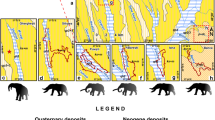Abstract
Molecular studies suggest that the lineages leading to humans and chimpanzees diverged approximately 6.5–5.5 million years (Myr) ago, in the Late Miocene1,2,3. Hominid fossils from this interval, however, are fragmentary and of uncertain phylogenetic status, age, or both4,5,6. Here I report new hominid specimens from the Middle Awash area of Ethiopia that date to 5.2–5.8 Myr and are associated with a wooded palaeoenvironment7. These Late Miocene fossils are assigned to the hominid genus Ardipithecus and represent the earliest definitive evidence of the hominid clade. Derived dental characters are shared exclusively with all younger hominids. This indicates that the fossils probably represent a hominid taxon that postdated the divergence of lineages leading to modern chimpanzees and humans. However, the persistence of primitive dental and postcranial characters in these new fossils indicates that Ardipithecus was phylogenetically close to the common ancestor of chimpanzees and humans. These new findings raise additional questions about the claimed hominid status of Orrorin tugenensis8, recently described from Kenya and dated to ∼6 Myr9.

Similar content being viewed by others
References
Ruvolo, M. Molecular phylogeny of the hominoids: inferences from multiple independent DNA sequence data sets. Mol. Biol. Evol. 14, 248–265 (1997).
Horai, S., Hayasaka, K., Kondo, R., Tsugane, K. & Takahata, N. Recent African origin of modern humans revealed by complete sequences of hominoid mitochondrial DNAs. Proc. Natl Acad. Sci. USA 92, 532–536 (1995).
Chen, F.-C. & Li, W.-H. Genomic divergences between humans and other hominoids and the effective population size of the common ancestor of humans and chimpanzees. Am. J. Hum. Genet. 68, 444–456 (2001).
Hill, A. in Integrative Paths to the Past: Paleoanthropological Advances in Honor of F. Clark Howell (eds R. S. Corruccini and R. L. Ciochon) 123–145 (Prentice Hall, Englewood Cliffs, 1994).
McDougall, I. & Feibel, C. Numerical age control for the Miocene–Pliocene succession at Lothagam, a hominoid-bearing sequence in the northern Kenya Rift. J. Geol. Soc. Lond. 156, 731–745 (1999).
Leakey, M. G. et al. A record of faunal change in the late Miocene of East Africa. J. Vert. Paleontol. 16, 556–570 (1996).
WoldeGabriel, G. et al. Geology and palaeontology of the Late Miocene Middle Awash valley, Afar rift, Ethiopia. Nature 412, 175–178 (2001).
Senut, B. et al. First hominid from the Miocene (Lukeino Formation, Kenya). C.R. Acad. Sci. Ser. IIa 332, 137–144 (2001).
Pickford, M. & Senut, B. The geological and faunal context of Late Miocene hominid remains from Lukeino, Kenya. C.R. Acad. Sci. Ser. IIa 332, 145–152 (2001).
Renne, P. R., WoldeGabriel, G., Hart, W. K., Heiken, G. & White, T. D. Chronostratigraphy of the Miocene–Pliocene Sagantole Formation, Middle Awash Valley, Afar rift, Ethiopia. Geol. Soc. Am. Bull. 111, 869–885 (1999).
White, T. D., Suwa, G., & Asfaw, B. Australopithecus ramidus, a new species of hominid from Aramis, Ethiopia. Nature 371, 306–312 (1994).
Latimer, B., Lovejoy, C. O., Johanson, D. C. & Coppens, Y. Hominid tarsal, metatarsal, and phalangeal bones recovered from the Hadar Formation: 1974–1977 collections. Am. J. Phys. Anthropol. 57, 701–719 (1982).
Latimer, B. & Lovejoy, C. O. Metatarsophalangeal joints of Australopithecus afarensis. Am J. Phys. Anthropol. 83, 13–23 (1990).
Day, M. H. Femoral fragment of a robust australopithecine from Olduvai Gorge, Tanzania. Nature 47, 230–233 (1969).
Ohman, J. C., Krochta, T. J., Lovejoy, C. O., Mensforth, R. P. & Latimer, B. Cortical bone distribution in the femoral neck of hominoids: implications for the locomotion of Australopithecus afarensis. Am. J. Phys. Anthropol. 104, 117–131 (1997).
Acknowledgements
The National Science Foundation, the Wenner-Gren Foundation, and the University of California at Berkeley provided funding. The Authority for Research and Conservation of Cultural Heritage of the Ministry of Information and Culture granted field permits, and the National Museum of Ethiopia granted access to the Paleoanthropological Laboratory before 13 February 2001. The success of this research is largely owed to the members of the Middle Awash research project and the Afar people. This contribution is dedicated to our late friend Neina Tahiro, who suggested the name ‘kadabba’, and to whom I give special thanks. G. WoldeGabriel played a major role in discovering fossiliferous hominid-bearing localities along the western margin of the Middle Awash study area and also studied the geology of the region. I thank T. White, B. Latimer, K. Geleta, H. Gilbert, D. DeGusta, L. Hlusko, E. Güleç, C. Pehlevan, B. Asfaw, M. Black, G. Suwa, S. Yosef, A. Amzaye, M. Asnake and H. Saegusa for their participation in survey and excavations. Sheikh Ebrahim and Shiekh Oumer helped coordinate the Afar labour force. I thank B. Latimer, O. Lovejoy and S. Simpson for their assistance during the comparative studies conducted at the Cleveland Museum of Natural History. O. Lovejoy, T. White and G. Suwa provided insights and comments. Advice, support and encouragement to conduct research along the western margin of the Middle Awash study area were extended by T. White and B. Asfaw.
Author information
Authors and Affiliations
Corresponding author
Rights and permissions
About this article
Cite this article
Haile-Selassie, Y. Late Miocene hominids from the Middle Awash, Ethiopia. Nature 412, 178–181 (2001). https://doi.org/10.1038/35084063
Received:
Accepted:
Issue Date:
DOI: https://doi.org/10.1038/35084063
- Springer Nature Limited
This article is cited by
-
Few dental indices in modern Bulgarian population from southern Bulgaria
Journal of Physiological Anthropology (2023)
-
Alternative Metabolic Strategies are Employed by Endurance Runners of Different Body Sizes; Implications for Human Evolution
Adaptive Human Behavior and Physiology (2022)
-
High heels enhance perceived sexual attractiveness, leg length and women’s mate-guarding
Current Psychology (2022)
-
Ineluctably us: early hominid discoveries, mass media, and the reification of human ancestors
History and Philosophy of the Life Sciences (2020)
-
Late Middle Pleistocene Elephants from Natodomeri, Kenya and the Disappearance of Elephas (Proboscidea, Mammalia) in Africa
Journal of Mammalian Evolution (2020)





